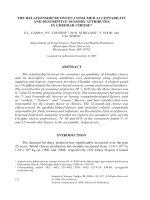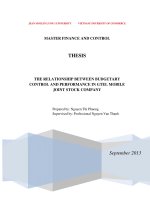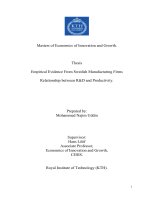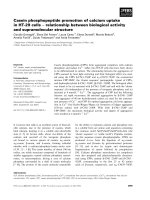Relationship between language, culture, and identity
Bạn đang xem bản rút gọn của tài liệu. Xem và tải ngay bản đầy đủ của tài liệu tại đây (1.2 MB, 31 trang )
Relationship between Language, culture,
and Identity
Presented to:
Miss Urooj Alvi
Presented by:
Tayyba Bashir
Amna Shamir
Memoona
Contents
Introduction
Language
Culture
Identity
Culture Influence Language
Language influence culture
Relationship between Language,
Culture and Identity
Conclusion
References
Introduction
Language and culture are intricately
related and dependent on each other.
Language is formed by culture, while
culture is influenced and impacted by
language.
Without language, culture cannot be
completely acquired nor can it be
effectively expressed and transmitted.
Without culture, language cannot exist.
Introduction
Membership in a culture influences identity.
Assumptions, beliefs, and values shared with
others are a large part of feeling something in
common with other people.
Identification with a culture results in striving
to gain membership in that culture.
Language
Identity
Culture
Language
Language can be defined as the system of
communication comprising codes and symbols which
are used by humans to store, retrieve, organize
structure and communicate knowledge and
experience.
It is the primary instrument in the expression,
transmission, and adaptation of culture.
The learning of a second or foreign language enables
one to view life through another cultural lens.
culture Identity
Culture
It is a set of beliefs, values, norms,
customs, traditions, rituals, and a way of
life that differentiates one group from
another.
Culture
culture has the ability to acquire
new characteristics and forms. It is
dynamic - its permutations can
take place from one generation to
another or from one geographical
location to another.
Identity
Norton (1997) defines identity as,
“How
people
understand
their
relationship to the outside world, how
that relationship is constructed
across time and space, and how
people understand their possibilities
for the future” (p. 410).
Note
Language, culture and Identity are
dynamic , complex and ongoing
processes.
Culture Influence Language
Lexicon, grammar rules, codes and rules of
linguistic communication are all entirely
formed by cultural elements like natural
environment, economic systems, types of
social relationships etc. etc.
Cultural premises and rules about
speaking are intricately tied up with
cultural conceptions of persons, agency,
and social relations.
Example
There numerous words to describe
‘snow’ used in the languages of
peoples living in cold countries. For
example freshly-fallen, icy, packing
snow etc.
Language influence culture
While on the one hand culture shapes languages, on
the other hand language is also formed by them.
Language is the medium of culture.
Example:
This is clearly seen in immigrant societies, for
example, in America. These immigrants are
accustomed to a certain language, and therefore,
despite the assimilation, will continue to use it and
keep it alive, creating different and cultured societies
in this foreign land to keep the language alive.
Language influence culture
Furthermore, not only is language an expression and a
display of heritage and history, it is also the
component of culture that makes it unique, and that
creates a difference from one to another.
“Linguistic differences are also often seen as the mark
of another culture, and they very commonly create
divisiveness among neighboring peoples or even
among different groups of the same nation. This
explains how language can be a pathway to culture.
Language and Thought
Thought processes and perceptions of
reality differ from one culture to another.
How people think and speak is ultimately
determined largely by their culture. We
call this Linguistic Relativity.
Linguistic Relativity
Benjamin Lee Whorf – Language and
thought are so intertwined that one’s
language determines the categories of
thought open to him or her.
– “simply stated, the Sapir Whorf hypothesis
says, that the content of a language is
directly related to the content of a culture
and the structure of a language is directly
related to the structure of a culture.
Sapir-Whorf Hypothesis
Language is not simply a means of
reporting experience; rather, it is also a
way of defining experience.
“Linguistic relativity is the degree to which
language influences human thought and
meanings. “
linguistic differences between cultures are
associated with cultural differences in
thinking.
Relationship between Language, Culture
and Identity
Culture and language shape one’s
identity and personality. There is much
importance of culture and language to
one’s individual identity. Language is a
powerful instrument of identity and
belonging.
levels of identification
There are
numerous
levels of
identification
that are
conveyed by
means of
language:
• The national level
• Rank or social class
• Level of sexual identity or
gender
• The level of generation
• The level of professional
identity
• Culture
The national level
The national level and the ethnic
and/or regional one, that for historical
reasons play a significant role and on
which we will dwell shortly.
Rank or social class
The expressions we use when speaking
to others always reflect the status
relationship between ‘them’ and ‘us’;
close, friendly relations or formal
reserve, respect and deference require
different forms of exchange.
Level of sexual identity or gender
• In all societies the ‘proper’ way for women to
speak is different from that for men, a
difference that sometimes goes as far as to
the methodical use of a special vocabulary
and of different syntactical structures. In
European societies it is usually inappropriate
for a woman to use expressions that are too
‘strong’ and direct, or to use pronunciation
that is the characteristic of dialect or slang.
The level of generation
• The words that teenagers use are very
distinct from what the older generations
might use.
• Teen speak is very good marker of identity
for teenagers. Similarly, adults and elderly
people use words that teenagers wouldn't
usually use, so they would be markers of
identity for adults.
The level of professional identity
• The identifying cohesive element here
is the sharing of technical and special
languages, of jargon that is not familiar
to the community at large.









